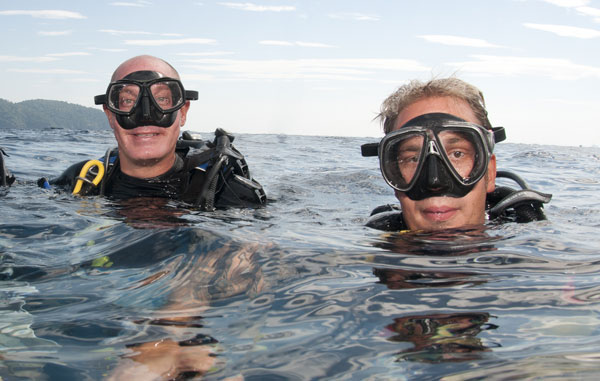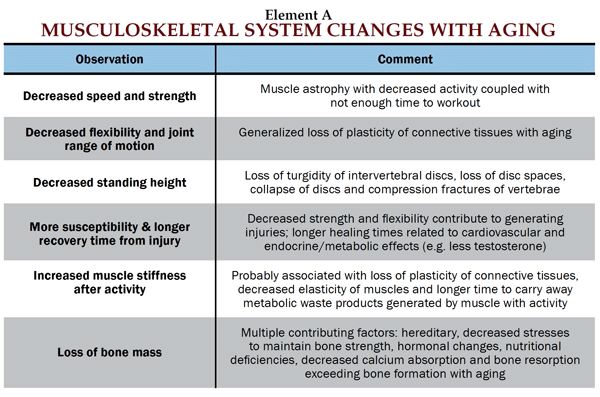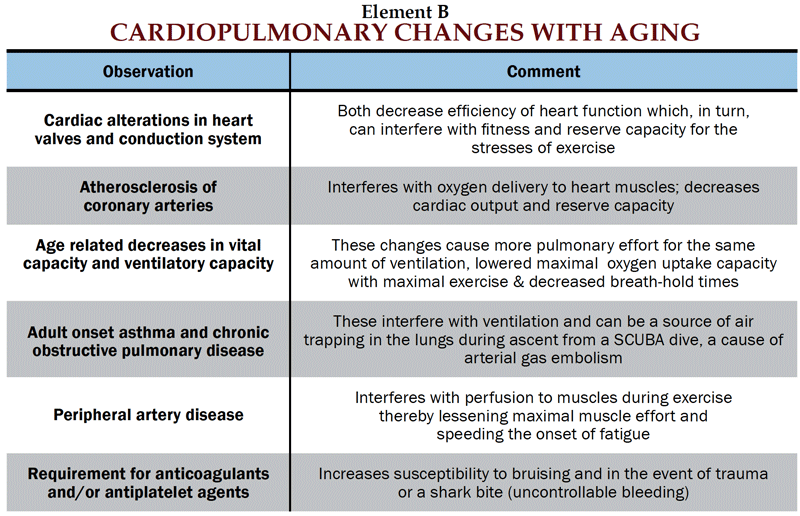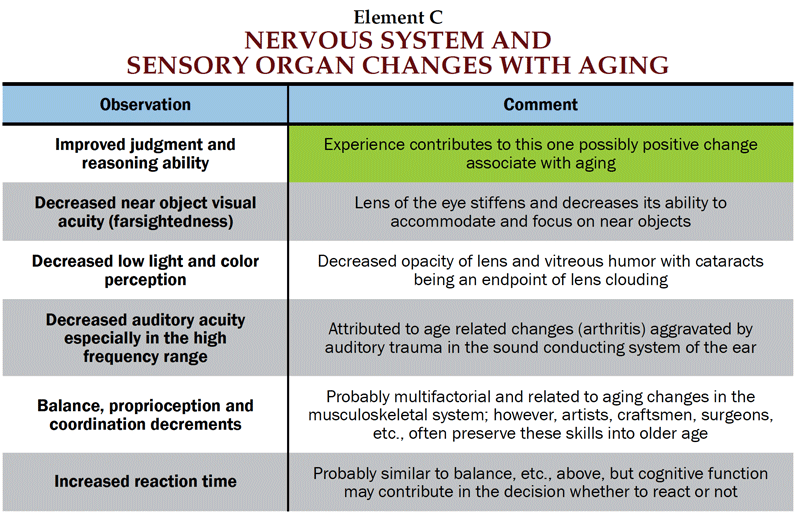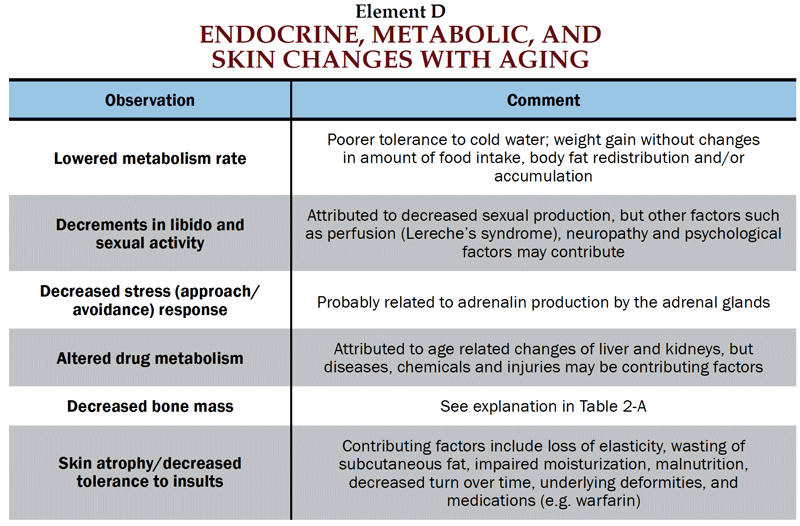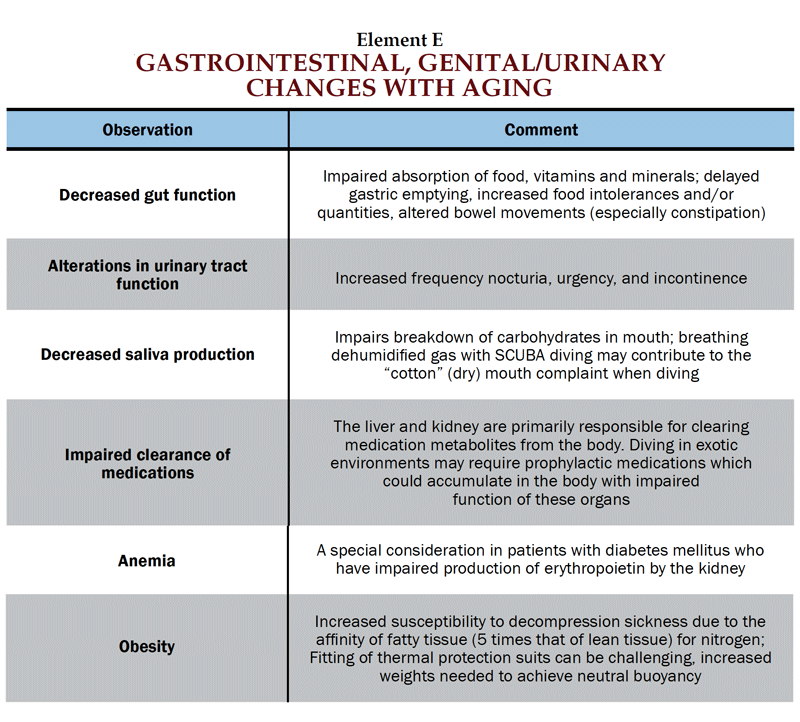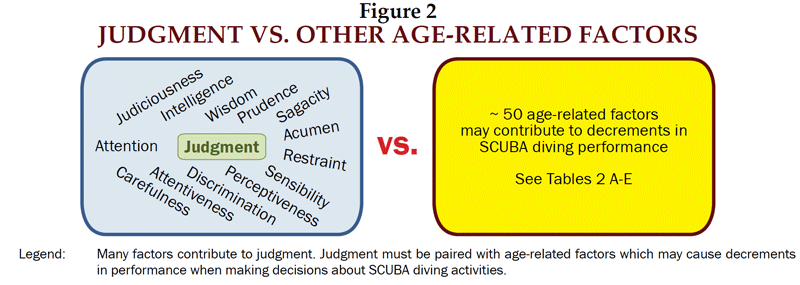Written by Michael B. Strauss, MD, FACS, AAOS
As the population gets older, coupled with increased awareness of good health practices and the recognition that fitness contributes to participation in activities generally appropriate for younger individuals, decisions need to be made about what are appropriate activities for the older aged scuba diver. It is essential to appreciate the distinction between chronological and physiological age. Three factors, namely fitness, co-morbidities, and mobility and strength are fundamental when making decisions about participation in activities in general and in scuba diving in older adults. There is almost always a time to “call it quits” for everything, including scuba diving. This article discusses the factors critical for making decisions as to whether or not the older aged diver should continue scuba diving activities.
It is noteworthy that when Social Security was enacted in 1935, the average age at death was 65. During that time only one in 23 workers who paid into Social Security lived long enough to collect benefits. Today, one in three workers collects Social Security benefits. Besides better attention to good health practices and more attention than ever to fitness, one-third to one-half of the medical or surgical treatments now available did not exist in 1965. The message is our society is getting older; we’re living longer and want to continue to do things formerly consider inappropriate in former times. Scuba diving is no exception.
Physiological versus Chronological Age
To define “old” requires amplification. It requires differentiation between chronological and physiological age which are not always the same (Figure 1).
Chronological age is a person’s actual age and does not consider cognitive function, comorbidities, experience, physical fitness, judgment, mobility and strength. In contrast, physiological age is highly subjective, often evoking comments that a person appears younger (or older) than his/her stated age would suggest. We consider physical fitness, health status, and cognitive function as the three main considerations for defining apparent age.
Measures to judge physiological age such as ability to do activities of daily living, capacity for doing exercise/sport pursuits, participation in social activities, and work status. Other less objective considerations include cognitive function, creativity, capacity to recover from illness or injuries, tolerance to sleep deprivation, and quickness to regain physical fitness (i.e. getting into “shape”) after periods of inactivity. We designed a quick and easy-to-use tool to quantify a person’s health status (Table 1).
The tool consists of summating five assessments each graded from 2 (best) to 0 (worst) to generate a 0 to 10 score. The assessments include: 1) ability to do activities of daily living, 2) ambulation, 3) comorbidities, 4) smoking/steroid history (whichever gives the lower score) and 5) neurological deficits. Scores of 8 to 10 points quantify the person as “healthy,” 4 to 7 points as “impaired,” and 0 to 3 points as “decompensated.” Information quickly obtained from this tool helps assess the general health of a SCUBA diver and provides guidelines as to who should and should not dive.
As we get older there are changes in the function of our body organs and organ systems (Table 2 and Elements A-E).
(Note: Click to enlarge any of the images on this page)
The appreciation of changes that occur with aging in different body systems help in decision making for participation, modifying or discontinuation of an activity. For example, contrast the time an athlete can actively play football versus golfing or swimming. Changes occur in our bodies when getting older and almost all hinder performance. The one change that may improve with aging (and experience) is judgment. Improved judgment can help compensate for deterioration in the other items that occur in the body which impose limitations for SCUBA diving. For example, the older diver may limit his/her diving to easily accessible sites that have optimal diving conditions. Consequently, improved judgment as a favorable change has to be balanced with changes which can deteriorate function when making decisions about SCUBA diving as one gets older (Figure 2).
While the internet is replete with information defining aging, older age, seniors, elderly, older adults, geriatrics, silver years, mandatory retirement, etc., the distinction is not clear cut between old and not old when considering humans. Some gerontologists make a distinction between young-old (55-74) and old-old (75 and older).1 The question of “old” is clouded by societal norms. One example of this is becoming eligible for full benefits for Social Security in the USA at 66 years of age, but even this criteria is expected to increase with increasing productivity and longevity of our population over this arbitrary age.
Another way to look at aging is through physical and cognitive changes such as graying of hair, loss of near vision, decreased libido,
impaired hearing, slower and/or less cognition skills, reduced ability to recover from injury, thinning of bones, muscle atrophy, decreased food tolerances and quantities, difficulty integrating new technology (i.e. Future Shock) and so on (see Table 2). However, it is obvious that these changes occur over a wide range of ages and extremely variable degrees of seriousness.
A third way of looking at aging is through quotations such as “old age is when you feel old,” “you’re old when you’re no longer able to do things that you able to do when younger,” “aging is when it is hard to get out of bed in the morning and you are stiff all over,” “old age is when you no longer have a youthful outlook,” “old age occurs when managing ailments (i.e. with medications, restricted activities, etc.) takes precedence over doing activities.”
For our purposes with respect to SCUBA diving in older ages, the three crucial considerations are fitness, comorbidities and mobility/strength. These three criteria are the focus of this article.
Fitness as a consideration for SCUBA Diving in Older People
We define physical fitness as the readiness or ability, especially in cardiovascular, respiratory and musculoskeletal systems, to perform tasks requiring increased energy expenditure such as extrication in a diving emergency. However, no standards for diving exist for the recreational SCUBA diver. Bove recommends that the ability to do 13 METS (metabolic equivalents) of exertion on a treadmill test is an essential consideration for SCUBA diving.3 The Divers Alert Network (DAN) study shows that 7-8 METS of exercise capacity is adequate for non-emergency SCUBA diving activities.4
Some associations have their own exercise standards such as the IADRDS (International Association of Dive Rescue Specialists) and their Watermanship Testing standards (Table 3). While being able to meet the highest scoring levels is not practical for most recreational SCUBA divers, the testing does provide physical fitness criteria for the diver to judge himself/herself.
We feel that the diving activity should be paired with the level of physical fitness anticipated to be necessary to safely do it. Pre-dive planning and dive site selection are two essential practical considerations. High versus low energy demands go hand-in-hand with the dive site (Figure 3). Ocean currents, drop and pick-up (i.e. free boat) diving, visibility, water temperature, and number of dives all contribute to the level of exertion required for the dive.
The older aged diver (as well as all other divers) should select activities that are commensurate with his/her levels of fitness, mobility/strength, and anticipated swimming needs for the dive. “Soft” criteria for these decisions can be based on limiting the depth of a dive to the distance that can be easily swum underwater in a swimming pool after a single breath, or equating expected
swimming distances on the dive to the distance the diver can comfortably swim in a pool with fins.
In summary, fitness to dive should be based on physiological age and the ability to do sustained aerobic activities rather than chronological age. The older aged diver should assiduously adhere to diving safety and conservative practices. For example, the older aged diver should use the most “conservative” option on the dive computer, always do slow ascent rates and do the 15 foot three minute rest stops, carry safety/signaling equipment, SCUBA dive only under optimal diving conditions, and take a break from diving after several days of continuous, multiple dives per day. With these recommendations, SCUBA diving in the older aged adult need only be discontinued when they (including underwater and surface swimming capacity) are not met.
While use of a wetsuit does not seem a significant consideration with regard to fitness, consider the following scenario. While diving
in cool, current-laden, offshore Island waters, travel luggage weight restrictions made it necessary to use “production” neoprene 7 mil thick wetsuits provided by the dive operator. The buoyancy from the wetsuit alone required about 35 pounds of weight to become neutral in the salt water. The stiffness of the wetsuit and the difficulty of maintaining the weight belt at waist level made for a less than pleasant dive experience and very considerably increased the exertion required to execute the dive. No less than one older diver surfaced “ill” from the dive with nausea, vomiting, fatigue, and malaise—and after careful evaluation it was ascertained that the symptoms were due to the exertion from the dive.
Considerations for SCUBA Diving in Older Aged People
Comorbidities are other medical conditions that co-exist with a primary condition. For our purposes, the primary condition is “older” age which is, as described before, defined by the beholder. There is general agreement as to what medical conditions constitute absolute, relative, and temporary contraindications for SCUBA diving.3,6 Medical comorbidities that impose absolute or temporary limitations for SCUBA diving are generally independent of age such as seizure disorder, decompensated cardiac conditions, neurological conditions that severely interfere with mobility, impaired pulmonary function, and narcotic addiction. The older the diver, the more likely medical contraindications to continue recreational SCUBA diving will develop or already co-exist (Table 4).
The significant question regarding comorbidities and SCUBA diving (regardless of age) are those conditions that are relative contraindications to dive. Examples include asthma, impaired but not decompensated cardiac function, diabetes mellitus, kidney disease, blindness, residuals of strokes, paraplegia, Raynaud’s disease, cerebral palsy, extremity amputations, myopathies, cognitive function deficits, residual impairments from a previous episode of decompression illness, and similar serious conditions. With all of these conditions, individuals can safely SCUBA dive, with appropriate guidance and dive buddies. To decide whether or not a “wanna be” diver can safely dive with a relative contraindication to diving requires evaluation and medical clearance by a physician knowledgeable in diving medicine. Often, ancillary testing is required such as stress electrocardiograms to evaluate impaired cardiac function, pulmonary function tests for lung disease, etc. The decision to dive with a relative contraindication is difficult to make and is appreciably related to the motivation of the individual and his/her support systems for SCUBA diving rather than just the age itself of the diver.
Mobility and Strength as the Third Consideration for SCUBA Diving in Older Aged People
Mobility and strength in SCUBA diving relates to the ability to move from one place to another and to move joints through a functional range of motion sufficient to don and doff gear, enter and exit the water and to be mobile while in the water. Strength with reference to SCUBA diving is a matter of being able to lift dive equipment, carry the equipment to the entry site, and make safe entries and exits from the water. For open water dives this may require shimmying onto a small craft. Mobility and strength are the most poorly defined of the three age-related considerations for SCUBA diving. Although many of the age-related changes in performance and medical contraindications for diving have mobility and strength ramifications, only in their most extreme manifestations are they a contraindication to SCUBA diving.
Of the three considerations for continuing or discontinuing SCUBA diving, mobility and strength are probably the most important for making age-related decisions to terminate diving. With experience, medications, and controlling the diving environment, fitness and comorbidities can be mitigated. Mobility and strength deficits can be somewhat mitigated in the older aged diver with non diving exercise activities that help maintain joint flexibility and muscle strength in addition to aerobic exercises to maintain fitness.
The older aged diver will probably self-terminate SCUBA diving when it is too hard to do, is no longer worth the effort, nor is it fun anymore. These reasons are significantly related to impaired mobility and muscle strength.
Older Aged SCUBA Diver Case Scenarios
Fitness Considerations
A 65-year-old male diver maintains an avid interest in SCUBA diving. Typically he dives four to five times a year at exotic dive locations doing as many five dives a day. Although not an aerobic exercise fanatic, he maintains good health practices, weight control, and exercises almost daily. He carefully selects dive locations requiring minimal fitness demands such as reef and lagoon dive sites with warm water and excellent visibility, and uses anchor/buoy lines for ascents descents whenever possible. He adheres to recommended ascent rates and the 15foot/3 minute rests stops at all times. He uses a dive computer set to the most conservative mode, does not dive over 70 foot depths, and never dives to the extent that this computer goes into the yellow zone.
This older aged diver exemplifies one who follows our age-related fitness recommendations. His diving fitness is substantiated by his 50-plus dives per year. His selection of diving sites and in particular the avoidance of open ocean drift dives and cold water
diving obviates age-related fitness contraindications to diving.
Comorbidity Considerations
A 67-year-old male diver who exercises almost daily with kayaking, bicycling, and/or swimming required coronary artery bypass stenting for angina. Post-stenting he was placed on Plavix® for its prophylactic anti-platelet adherence activity. He resumed his pre-stenting exercise activities with no restrictions including SCUBA diving. The major concern from SCUBA diving was felt to be bleeding from anticoagulation should a traumatic injury occur. However, he felt that there was no more risk of this occurring with recreational SCUBA diving than with his other exercise activities.
This older aged diver’s comorbidity, i.e. a compensated coronary artery disease condition is a relative contraindication to SCUBA diving. His superior conditioning makes fitness and mobility and strength considerations essentially “non-concerns” with respect to being an older aged SCUBA diver. Nonetheless, he dives conservatively and limits his dives (but not necessarily depths) to two to three a day—often with a day’s break after three to four days of consecutive diving.
Mobility and Strength Considerations
A 68-year-old male developed increasingly severe degenerative joint disease pain symptom in his left hip. A cane became necessary for all walking activities. In the water his swimming ability and conditioning plus the offloading effect of buoyancy in the water compensated for the decreased mobility of his hip joint. While in the water he had almost total relief of his hip pain symptoms.
With each successive year of diving activities, it became increasingly difficult to don and doff diving gear, carry the gear when suited-up and make water entries and exits. A beach entry dive was very challenging and required the assistance of two companion divers to enter the water from a sandy beach. After a total hip replacement, the hip pain, strength, and mobility problems were arrested and greatly facilitated the diving related activities when not actually in the water.
The need for a total joint arthroplasty (i.e. total hip joint replacement) is a relative contraindication for SCUBA diving. When fitness and comorbidity considerations are absent or suitably managed, a functional total joint replacement is not a contraindication for diving.
Conclusions
SCUBA diving for older aged individuals raises many questions. One is defining what older age is. For the purposes of SCUBA diving, the physiological age is a far more important consideration than the chronological age. Another question is what criteria needs to be used when making decisions about whether or not to SCUBA dive. The three important considerations of fitness, comorbidities, and mobility and strength offer criteria for making the decision. When comorbidities present relative contraindications to diving, a decision whether or not to SCUBA dive requires evaluations by and recommendations for SCUBA diving from a physician knowledgeable in diving medicine. Safety becomes the primary concern when making recommendations about diving with relative comorbidities. Finally, the decision for when an older aged SCUBA diver (whose fitness, comorbidities, and mobility and strength are not mitigating factors for not diving) should stop diving largely rests with the diver. In this situation, the decision to stop SCUBA diving becomes a matter when it is “no longer fun.”
Reprinted with permission from the publisher
References
1. Ohio State University Extension. When does Someone Attain Old Age? http://ohioline.osu.edu/ss-fact/0101.html
2. Boss, M.D. and Seegmiller, M.D., 1981. Age-Related Physiological Changes and Their Clinical Significance. Geriatric Medicine. West J Med 135: 434-440.
3. Alfred A. Bove. Cardiovascular Disorders and Diving. Chapter 25. Bove and Davis Diving Medicine. Elsevier Inc. 2004: 493.
4. Pollock NW, Natoli MJ. Aerobic Fitness of Certified Divers Volunteering for Laboratory Diving Research Studies. Undersea &
Hyperbaric Medicine. 2009; July/Aug; 303-304.
5. I.A.D.R.S. Annual Watermanship Test, http://www.iadrs.org/media/IADRS_Watermanship_Test.pdf
6. Strauss, M.D. and Aksenov, M.D., PhD. 2004. Medical Preparation for Diving: Fitness and Nutrition. Diving Science. Human Kinetics: 185-205.
About the Author:
Michael B. Strauss, MD, FACS, AAOS, is well known to the readers of Wound Care and Hyperbaric Medicine, having contributed six Featured Articles in recent editions. Among his interests in hyperbaric medicine is understanding the mechanisms of hyperbaric oxygen. At the 1988 UHMS ASM, Dr. Strauss first presented on hyperoxygenation, vasoconstriction, and host factor mechanisms. Since then he has continually refined and updated his hyperbaric oxygen (HBO) mechanisms presentations. In his text MasterMinding Wounds, he discusses the mechanisms that especially pertain to wound healing while differentiating HBO mechanisms as primary and secondary.
Best Publishing Company is the world’s foremost publisher of books on diving and hyperbaric medicine. For more information and resources, please visit the Best Publishing Company website www.BestPub.com. You can reach them at info@bestpub.com or (561) 776-6066.

